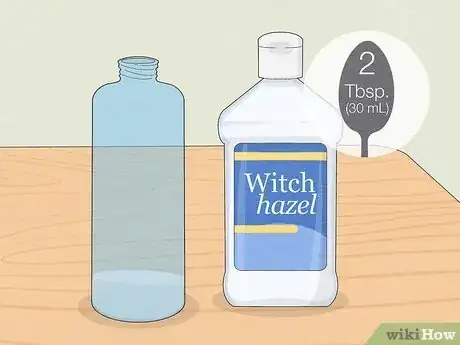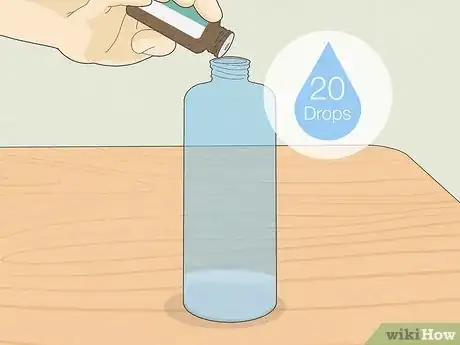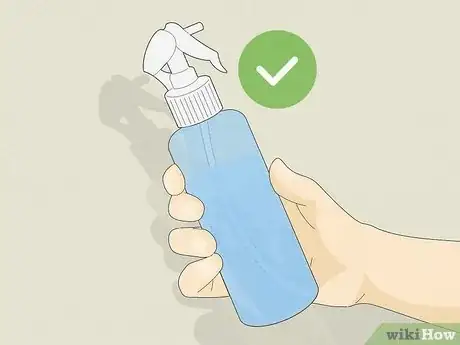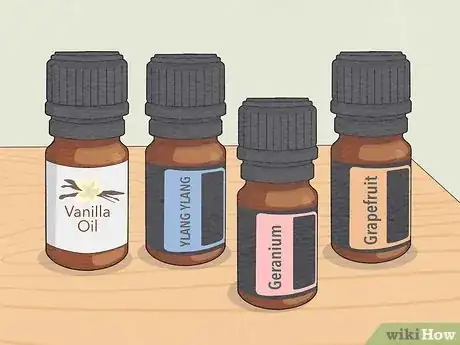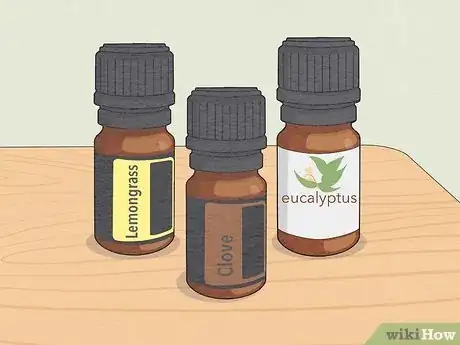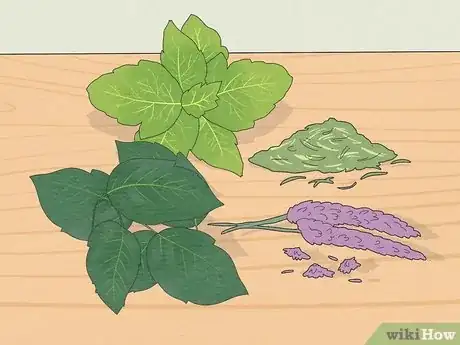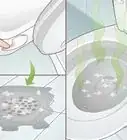This article was co-authored by Ritu Thakur, MA and by wikiHow staff writer, Aly Rusciano. Ritu Thakur is a healthcare consultant in Delhi, India, with over 10 years of experience in Ayurveda, Naturopathy, Yoga, and Holistic Care. She received her Bachelor Degree in Medicine (BAMS) in 2009 from BU University, Bhopal followed by her Master's in Health Care in 2011 from Apollo Institute of Health Care Management, Hyderabad.
There are 16 references cited in this article, which can be found at the bottom of the page.
This article has been viewed 4,171 times.
Wanting to add a bit of aromatherapy to your daily life? Then try making your own DIY essential oil spray! From air fresheners to perfumes to bug repellents, essential oil sprays have tons of benefits and uses. These sprays are super simple to make and only require a few ingredients. In this article, we’ll teach you how to make a standard essential oil spray base and then help you tailor it to your needs. So, pick out your favorite oils and get ready to add some calming, invigorating, or refreshing flavors to your life.
Things You Should Know
- To make 4 oz (118 ml) of essential oil spray, combine 2 tbsp (30 ml) of witch hazel, 20 drops of essential oil(s), and 6 tbsp (89 ml) of water in a 4 oz spray bottle.
- Use citrus oils like geranium, wild orange, and lime when making perfumes and air fresheners.
- Try relaxing and grounding scents like lavender and bergamot essential oils to calm anxieties and help you sleep.
Steps
Essential Oil Spray Recipe
-
1Pour 2 tbsp (30 ml) of witch hazel into a 4 oz (118 ml) spray bottle. Witch hazel is the perfect base for your spray because of its natural anti-inflammatory and antioxidant properties.[1] Use a tablespoon to measure out your witch hazel and add it to the bottle. For fewer spills, try using a small funnel.[2]
-
2Add at least 20 drops of essential oil(s) to the spray bottle. The more drops you add, the stronger your essential oil spray’s fragrance will be. Start with 20 drops, smell, and add more if you’d like.[4]
- Use one essential oil for your spray, or try blending two or more oils for a customized scent.
- Pick an essential oil or blend that matches your needs. For instance, pick a floral or citrus oil for a room spray or a calming blend for a pillow spray.
Advertisement -
3Pour 6 tbsp (89 ml) of water into the witch hazel and oil mixture. Water helps dilute your essential oils and give your spray volume. Simply measure out your water with a tablespoon and use a funnel to gently add it to the spray bottle.[5]
- Consider using distilled water to ensure that your water is clean and free of contaminants.
- Diluting your essential oils is incredibly important because putting oils directly on the skin can cause severe irritation.[6]
-
4Twist on the cap, shake, and spray. All that’s left to do is put on the lid and mix your spray up! Shake the bottle vigorously to make sure the oils are incorporated.[7] Use your DIY essential oil spray for 4 to 6 months or until the fragrance starts to fade.
- It may take a few squirts for the spray to start working, especially if this is your first time using the spray bottle.
- Shake the bottle before each use, as the oils will naturally separate over time.
Best Essential Oil Blends
-
1Brighten your mood with lemon, lime, and wild orange. Citrus aromas can combat negative feelings, making this the perfect blend to spray in your office during a stressful work day or in your bedroom right when you wake up. Simply add about 7 drops of each oil to your spray bottle, spritz, and feel uplifted.[8]
- Play around with how much of each oil you add to your spray. If you like the smell of lemon more, add an extra few drops of it!
-
2
-
3Combine vanilla, ylang-ylang, geranium, and grapefruit for a perfume. When combined, these essential oils create a sweet floral scent that’s perfect to wear on your skin. Use about 10 drops of vanilla, 10 drops of ylang-ylang, 5 drops of geranium, and 5 drops of grapefruit.[10]
- Experiment with how many drops you add of each oil—make the perfume unique to you!
-
4Mix lemongrass, clove, and eucalyptus for a mosquito repellent. Studies have shown that mosquitos hate the smell and taste of these essential oils. Because of this, an equal combination of these 3 oils can make a strong fragrance that naturally protects you from bug bites.[11]
-
5Add lavender to your spray to help you sleep. Lavender is a naturally calming oil. It’s been proven to reduce anxiety and alleviate stress, making it an excellent oil to use right before bed. If you have trouble sleeping, try spritzing some lavender essential oil spray on your pillow to help you doze off.[12]
-
6Combine bergamot and clary sage for a stress relieving spray. The aromas from these oils can help you feel grounded and calm. Add equal amounts of bergamot and clary sage to your bottle to create a relaxing room spray to use in the office, car, or before bed.
-
7Make a peppermint spray for headaches, muscle pain, or itching. Peppermint essential oil is known for its cooling and mood-lifting properties, making it the perfect natural remedy. Studies have shown that the presence or application of this oil can help reduce headaches, ease pain, and soothe skin.[13]
- Always be careful when applying essential oils to the skin. Even when diluted, peppermint could irritate rashes. Consider talking to a health care provider before treating your skin with peppermint.
-
8Add dried herbs or flowers to your blends if you’d like. Who says your essential oil spray has to be one note? Plopping a few dried herbs or flowers into your spray bottle will infuse the mixture with even more fragrance. Try pairing oils with their dried versions or pairing them up like so:[14]
- A blend of bergamot and sandalwood with dried jasmine.
- A blend of vetiver and peppermint with dried rosemary.
- A blend of basil and rosemary with dried peppermint.
Things You’ll Need
- 4 oz (118 ml) spray bottle
- Witch hazel
- Water
- Essential oils
- Tablespoon
- Funnel (optional)
References
- ↑ https://www.ncbi.nlm.nih.gov/pmc/articles/PMC3214789/
- ↑ https://youtu.be/r37TqCd8R-4?t=40
- ↑ https://youtu.be/y6Cl5VEADjE?t=693
- ↑ https://youtu.be/r37TqCd8R-4?t=71
- ↑ https://youtu.be/r37TqCd8R-4?t=112
- ↑ https://www.hopkinsmedicine.org/health/wellness-and-prevention/aromatherapy-do-essential-oils-really-work
- ↑ https://youtu.be/y6Cl5VEADjE?t=1429
- ↑ https://youtu.be/zvp3N6qgKUU?t=195
- ↑ https://youtu.be/8vaAFpgFREo?t=50
- ↑ https://youtu.be/Ja6zgJ9ok7E?t=230
- ↑ https://www.ncbi.nlm.nih.gov/pmc/articles/PMC6189689/
- ↑ https://www.ncbi.nlm.nih.gov/pmc/articles/PMC3612440/
- ↑ https://www.nccih.nih.gov/health/peppermint-oil
- ↑ https://achs.edu/blog/2018/03/09/blending-101-the-art-of-pairing/
- ↑ https://www.hopkinsmedicine.org/health/wellness-and-prevention/aromatherapy-do-essential-oils-really-work
- ↑ https://www.aspca.org/news/essentials-essential-oils-around-pets
- ↑ https://www.foundanimals.org/essential-oils-toxic-pets/
